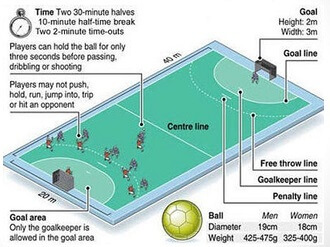Positions in Handball | Table of Contents
Table of Contents
There can be no more than seven (7) handball positions participating in the game at any one time. There should always be one goalkeeper and six outcourt players.
Two fullbacks (left and right), a ‘center’ backcourt player, two wingers (left and right), and a circle runner (called ‘pivot’) make up the outfield team.
And the jersey numbers?
Most players will have a number on the back of their handball shirts. Thus, the primary purpose of the positions numbers is for positional identification.
Explanation: The handball equipment list allows each player to choose their shirt number at the start of the season. But, team numbers do not correspond to any particular positions in handball for the modern game.
Goalkeeper (Number 1)
The goalkeeper is the player with the responsibility of defending the goal. He (or she) can do so, using almost any part of their body.
Goalkeepers are the only member in a team who can touch the ball ‘legally’ with their feet. So, a good handball goalkeeper will stop or deflect shots fired at them by the opposition.
In short, a goalie needs to have quick reactions. They need to be agile and they should also be good at reading the game.
Note: To avoid confusion, the handball goalkeeper kit will be different to the shirt and gear worn by the rest of the team members.
Left and Right Back (3 & 6)
The left and right backcourt players form a large part of the back line. They would usually be positioned to the left and the right of the center back.
As a rule both backcourt members will have a rather imposing build and will often be the largest players on a team.
Together with the center, they all form a wall of defensive power and accuracy. Their main role is trying to prevent the opposition from shooting (and scoring).
When defending, they try to block shots and cover the circle runner. But, these handball players positions (pp) often become free-scoring long-range shooters when the team is in an attacking mode.
Handball Position Center (Number 4)
Often referred to as the center-back or center-half, this player primarily occupies the middle of the court. The center spearheads the attacks and shoots or tries to penetrate the defence.
The player in this handball position is also called the ‘team point guard’ – according to common handball terminology.
So, the player would also handle any blocking roles made by the opposition’s pivot, while the team is defending.
Center players occupy the creative European handball positions of playmaker. It is typical for them to direct play in a handball defense and attack.
Left and Right Wing (2 & 7)
The player occupying the left wing would usually be right-handed. They cover the left hand side of the court. Whereas the right wing player will usually be a left-handed player. Their role is covering the right hand side of the pitch.
 These wing players stand on the far left and right side of the defense while the team is defending (along the touch line).
These wing players stand on the far left and right side of the defense while the team is defending (along the touch line).
They initiate counter-attacks along the lines when the team pushes forward.
As a rule, the left and right wing players are smaller than their teammates. But, they are usually very fast and agile patrolling the lateral sides of the court.
They typically have excellent technical skills with a high degree of wrist flexibility for shot control.
Left and right wingers are busy countering their opposing numbers. They are always looking to create openings for others in attack mode. They are best known for making shots at goal from difficult wide angles.
Handball Pivot Position (Number 5)
The role of pivot in handball is that of an attacking player. The pivot player is also called the ‘line player’. These handball positions play most of the game along the 6 metre line at the opposition baseline.
This circle runner (or pivot) forms a close partnership with the centre back. They both try to exploit gaps and weaknesses in the defence of the opponents.
Number 5 in handball is also required to shoot and often has to do so while unbalanced or while moving through the air.
They would generally play in front of their defense trying to intercept the ball. A pivot would also try to prevent the opponents from passing when they attack.
The circle runner is quick and is always among the other team’s defenders. So, their chief role is either creating openings for teammates or getting into a good scoring position themselves.
Substitutes
Check the codified handball rules and regulations for further information on player substitutions. They can occur at any time during the game and without limits or stoppage time.
As a general rule, each team can have up to seven (7) substitutes waiting on the sidelines ready to join in the action.
A substitute cannot begin playing until the player they are swapping for has completely left the pitch. This is one of the main handball court rules that apply to player substitutions.
Officials in Handball
There are four (4) handball officials and their duties vary. Thus, a scorekeeper, a timekeeper, and two (2) referees will make up the composition.
As you might expect, the chief role of handball officials is controlling the play while at close quarters and overseeing fouls and misconduct.

